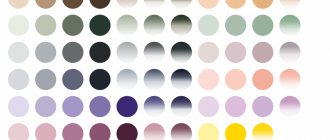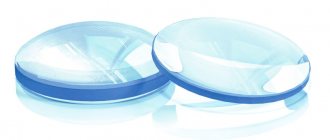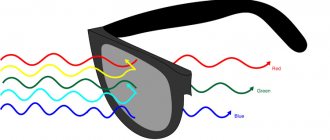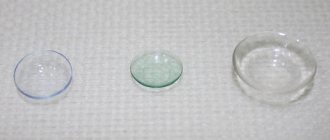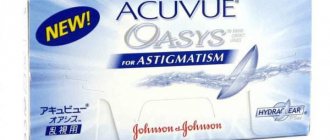How photochromic glasses work
The principle of operation of photochromic glasses is quite simple: thanks to the special material from which their lenses are made, they can darken when exposed to ultraviolet light. The fact is that ultraviolet radiation changes the spatial structure of the molecules that make up the lenses, the brightness of the light decreases, and photochromic glasses actually turn into sunglasses with a darkening level corresponding to the lighting.
As soon as the exposure to ultraviolet radiation stops, the spatial structure of the molecules changes again, returning to their original state, and the lenses again become transparent.
The level of surface darkness does not affect the image quality at all: it remains clear and contrasty.
The first chameleons appeared on sale at the end of the last century and were somewhat different from those presented in stores today: they reacted not only to exposure to ultraviolet radiation, but also to cold. The colder the weather, the darker the lenses became, regardless of light level. And in hot weather, even with enough sunlight, the glasses could not get dark enough. Fortunately, modern models do not have this drawback, so their level of darkness depends only on the lighting.
How and from what are photochromic glasses made?
There are glass photochromic lenses and plastic ones. They are made in different ways. Thus, for the production of tinted glass, molecules with a photochromic structure are used: a special substance is brought to a liquid state and added to the glass, after which it is evenly distributed in it and hardens.
The production of a plastic lens is different from the production of photochromic glasses. There are three methods for making such optics:
- Photochrome in a liquid state is added to plastic and hardens in it.
- The plastic is impregnated with photochrome.
- The finished optics are “finished” using a special photochromic coating applied to the front side of the lenses.
What are the features and advantages of photochromic glasses?
The main distinguishing feature and advantage of photochromic glasses is that they can be worn in any light level and feel comfortable. Your eyes will be protected from bright sunlight, they will not be afraid of glare, you will not have to squint when going outside or take off your glasses when you enter a dark room. They react almost instantly to changes, reduce eye strain and increase the contrast of vision.
They can be more convenient than classic sunglasses, which have a fixed level of shading, while photochromic ones become lighter and darker, adapting to external conditions. They won’t be too dark if it suddenly becomes cloudy outside, and the sun won’t blind your eyes if it suddenly starts to shine brighter than just a few minutes ago. Having just one photochromic glasses on hand will help you feel comfortable in a variety of situations, provide your eyes with an optimal level of sun protection and provide additional protection from UV rays.
But such lenses have one more feature: their service life is shorter than that of ordinary prescription glasses or sunglasses. The ability to become lighter and darker is lost over time, and the more often you wipe them, the faster they lose their properties. But we do not recommend wiping the surface less often than necessary, as such behavior can negatively affect your vision.
On average, the service life of the product is 3-5 years. Although there are models with special coatings that prolong it.
Ultra thin aspherical design spectacle lenses SEIKO AS 1.74 SCC
Everyone wants to look stylish, aesthetically pleasing and fashionable. This requirement also applies to our medical glasses, especially if high diopter values are required for vision correction. Introducing the ultra-thin and aesthetic SEIKO AS 1.74 aspherical lenses. If you have high diopters, then only the use of this type of lenses will keep the finished glasses on your face airy and attractive.
Go to the SEIKO AS 1.74 spectacle lenses page.
If, according to your ophthalmologist's prescription, you require lenses with high vision correction parameters or high values of astigmatism, then SEIKO AS 1.74 brand lenses will fit perfectly into such new glasses. Thanks to the patented aspherical surface design and ultra-thin Japanese RS-22 material, the lenses in the glasses are light and ultra-thin.
The aesthetics of the appearance of medical glasses is an important factor in the choice for large diopters in the prescription. By using high-index 1.74 lenses and aspherical design, you can significantly neutralize the effect of “your own eye enlargement”, making your appearance more natural for your interlocutor.
SEIKO AS 1.74 lenses made from RS-22 material have fairly good flexibility and strength, allowing them to be installed in any type of frames, including rimless ones. They are 50% thinner than traditional 1.50 index plastic lenses and more than 60% lighter than glass lenses. The material itself has natural protection against harmful UV radiation up to 395nm.
The special aspherical design applied to these spectacle lenses provides a wide field of clear vision compared to conventional spherical lenses, and a special 10mm spherical core (SEIKO MX-Design patent) ensures instant adaptation to the new lenses.
As standard, all SEIKO AS 1.74 SCC aspherical lenses come with premium SuperCleanCoat (SCC) applied on both sides. So, when buying spectacle lenses, you automatically receive a high-quality finished product.
Additionally, options for spectacle lenses with super-strengthening multi-coating SuperResistantCoat (SRC) are available for order. If you often work at a computer, with mobile devices or under artificial office lighting, we recommend ordering a separate option - a special multi-coating SEIKO SuperResistantBlue (SRB) blue blocker, which has additional protection against blue spectrum radiation up to 550 nm. Thanks to the SRB coating, the eyes receive significantly less blue radiation from artificial sources, which accordingly allows you to see the screen with more contrast and less strain when working for long periods at a computer monitor or on tablet devices.
Photo: seiko-optical.de
What are photochromic lenses?
As we mentioned earlier, photochromic glasses come in two types: glass and plastic. Each option has its own advantages and disadvantages, so we recommend studying the features of different types of photochromic optics before making a purchase, as well as consulting with an ophthalmologist who will take into account your lifestyle and preferences and, based on the information received, will be able to choose the best option.
- Glass lenses : their service life is about 3-5 years, after which they lose the ability to darken. But they have a drawback: the worse the patient’s vision, the greater the thickness of the glasses, moreover, it can be uneven, which means that such glasses darken unevenly. Thick glasses also have other disadvantages: such models put pressure on the bridge of the nose, can cause discomfort, and they also visually make the eyes smaller.
- Plastic lenses : they darken quickly and evenly, provide reliable protection from ultraviolet light, are much less dangerous than glass ones, and plastic is usually quite thin and light. But the service life of such products is shorter.
Also, photochromic glasses may differ in their darkening ability. This figure ranges from 10% to 85%. Be sure to check this before purchasing.
Photochromic lenses also differ in color. Most often there are models with gray or brown lenses, but thanks to modern technology you can also find gray-green models.
Depending on the indications, they distinguish:
- Aspherical optics. This option is prescribed for myopia (myopia), farsightedness (hypermetropia), senile changes in the organ of vision (presbyopia), and astigmatism. With such lenses you can get a full-fledged, clear image over the entire surface of glass or plastic - their main optical power is not concentrated only in the center. Another advantage is the thickness of the lenses: they are quite thin, so they do not put a lot of stress on them, and the effect of enlarging or shrinking the eyes is eliminated.
- Monofocal lenses. This is a classic version of glasses, as they have only one optical zone. They are not suitable for patients who have difficulty reading text in front of them or when viewing objects at a great distance. Therefore, this is not the most convenient option for drivers.
- Progressive lenses. They allow you to adjust the visibility of objects at different distances.
Polarized photochromic glasses
Polarized sunglasses perfectly block horizontal glare, so they are suitable for athletes, drivers, fishermen, fans of mountain sports and those who are going to spend their holidays on the seashore. Modern technologies make it possible to create polarized photochromic glasses. Their price is usually higher than classic models, but in many situations they can be much more convenient, since they protect from the sun and glare at the same time.
Photochromic glasses with diopters
Photochromic glasses with diopters are suitable for patients who want to correct their vision and protect their eyes from bright light. Thanks to the purchase of such optics, you don’t have to carry two pairs of glasses (with regular glasses for indoors and with dark lenses for outdoors) or choose what is more important: clear vision or protection from the sun.
Which lenses for glasses should I choose?
June 17, 2018
A global trend, good form and a sign of caring about your health is the individual production of glasses. And this means that by visiting an optical salon, you will have your eyesight checked, choose a stylish frame that suits you, and together with an optical consultant, decide which eyeglass lenses to install in this frame.
So that you do not get confused in the huge variety of lenses for glasses, we will share a convenient classification and the most detailed description of what lenses exist and how they differ from each other.
Material
First of all, lenses differ in the material they are made of :
— Glass (mineral, inorganic lenses)
Glass lenses are generally suitable for people who work in high temperatures (for example, with welding equipment).
Such lenses are resistant to scratches, thermal and chemical influences, they do not become cloudy or yellow over time, however, they have a number of disadvantages - they are heavy, fragile and dangerous and are suitable for installation only in rim frames.
— Plastic (polymer, organic lenses)
Optical plastic was discovered in the middle of the last century - it was a real revolution, and since then the material has been constantly improved. Modern developments in polymer lenses in combination with special coatings provide almost limitless possibilities for ensuring the highest quality vision in glasses.
Plastic lenses are lightweight, durable, non-traumatic, susceptible to coatings and staining, and are suitable for installation in almost any frame.
— Polycarbonate (lenses made of impact-resistant Trivex/PNX material)
These ultra-durable and extremely atraumatic lenses are recommended for children, athletes and users who have opted for rimless frames.
Design
The lenses also differ in design or, in professional terms, in the number of optical zones:
— Single vision lenses (have one type of correction)
Can be used to improve vision when reading, working at a computer, or for better visibility at a distance.
— Bifocal lenses (have two correction zones)
Suitable for older people and provide vision correction at distance and near. The vision correction zone at close distances is located at the bottom of the lens and has the shape of a “window”.
— Progressive lenses (have three correction zones)
Designed to correct vision simultaneously at far, medium and close distances.
And according to the shape of the refractive surfaces:
— Spherical lenses
A spherical lens is an unfinished sphere and has the same radius of curvature over its entire surface. A plus lens is thickest in the center and has thin edges; a minus lens, on the contrary, is thinnest in the center and thick at the edges. In such a lens, the image is clearly visible only through the center, but distortions may occur when looking at the periphery.
— Aspherical lenses
Such lenses provide excellent optical quality and minimize edge distortion (aberration), but require adaptation. Aspheric lenses are especially indicated for users who require glasses with high optical power (compared to spherical lenses, the lens is thinner and lighter).
— Lenticular
Designed to correct high degrees of hyperopia (farsightedness) and myopia (myopia) - from ±6.0 diopters. This lens has a given refraction only in the central part, and the periphery serves as the basis.
Thickness
Lenses are also distinguished by index (coefficient) of refraction , i.e. by thickness (the higher the index, the stronger, lighter and thinner the lens):
— Standard lenses (index 1.49 / 1.5 / 1.56) are heavy and visually slightly “narrow” the face and eyes in the lens area.
— Thin lenses (index 1.6 / 1.67) – recommended for medium and high refractive indexes and for installation in children’s glasses and rimless frames.
— Superthin lenses (index 1.74) – indispensable for high degrees of myopia and hypermetropia. These lenses make it possible to replace heavy and thick lenses with lighter and thinner ones for maximum comfort and aesthetic appearance of glasses.
Coatings
There are different protective lens coatings, which can also be broken down into:
— Anti-reflex coatings (anti-reflective, anti-reflective, UV protection, B lue B locker) – lenses with such coatings become more transparent and cleaner, provide image clarity, protect against glare and the harmful effects of ultraviolet radiation. There are also coatings that completely block the harmful blue light that is emitted by all electronic gadgets (computers, smartphones, tablets, etc.), while reducing eye strain and fatigue.
— Hardening coatings – increase the resistance of lenses to scratches and make polymer lenses similar in strength to glass.
— Hydrophobic (grease-, water-, and dirt-repellent) and antistatic coatings make lens care easier—they give smoothness, prevent water, dirt, and dust from accumulating, allowing the lens to stay clean longer.
Almost all manufacturers of spectacle lenses also offer multifunctional multi-coatings that combine several protective properties at once.
Light transmission
According to their influence on the intensity of the transmitted light flux, lenses are:
— Transparent - a classic option without color.
— Tinted – at the customer’s request, lenses can be painted in any of a variety of shades, with a gradient (with a transition from dark to light) or with a mirror coating.
— Photochromic (adaptive, “chameleons”) - control the amount of light received, gradually darkening on the street or in the car. When returned to the room, they brighten and become transparent again.
— Polarizing – neutralize the rays of polarized light, eliminate glare, increase contrast and color resolution, and also provide 100% UV protection.
Our optics stores feature lenses made in France, Germany, Japan, India, Korea, Great Britain, Belarus and other manufacturing countries. The cost of eyeglass lenses varies greatly and depends on many factors. Prices at Lenses for Free – from 290 rubles per lens.
To make your choice, you just need to answer 2 questions:
1. For what purposes do you need glasses? (for reading, driving a car or working on a computer)
2. What wearing mode do you plan? (all day or only during business hours)
The rest will be done for you by the Lenza for Free specialists. Selecting glasses for excellent vision is our daily task :)
We invite you!
Who is suitable for photochromic lenses?
- For people with photophobia or excessive tear production. Photochromic lenses are an excellent solution for those who want to protect their eyes from bright or dim light and generally care about the health of their eyes.
- For cyclists. It is important for cyclists, like drivers, to maintain visual acuity on the road. Photochromic spectacle lenses allow you to protect your eyes from the sun without having to give up corrective glasses.
- For athletes. It is not always convenient to exercise outdoors wearing vision glasses due to the lighting. In such situations, chameleons come to the rescue: in the light, their lenses become darker, the eyes feel comfortable, are protected from ultraviolet radiation, and the athlete does not have the desire to squint. These glasses are especially recommended for fans of mountain sports: tourists, skiers, etc., since in such areas the terrain is uneven, the snow reflects the sun's rays, and lenses that quickly respond to changes in light levels will perfectly protect the eyes.
- For people with ophthalmological diseases. For most diagnoses, it is important for patients to protect their eyes from ultraviolet radiation, and this can be done with the help of such lenses, because they can be worn continuously.
During sunny weather, people wear sun protection optics. But what to do when the sun is not so bright? Some people don't give up wearing sunglasses, while others prefer to take them off. In the first case, there is a risk of causing photophobia; in the second, the eyes continue to be exposed to the negative effects of ultraviolet rays. With photochromic glasses you don't have to choose what to do. In such lenses, the eyes do not need to adjust to different levels of illumination each time; the load on them is minimal.
Photochromic lenses Serengeti Polar PhD
Serengeti ophthalmic products first appeared in 1985. They were developed by Serengeti Eyewear technologists and were intended to protect drivers' eyes from the bright sun. The lenses quickly responded to ultraviolet radiation and “adjusted” to the light level. The eyes remained relaxed. There were several color options: amber, blue, pink, gold, gray or brown lenses. Based on automobile lenses, Serengeti Eyewear technologists began to develop other models of photochromic optics.
Several years ago, technologists from the American company Serengeti Eyewear announced work on the production of photochromic lenses for Serengeti Polar PhD glasses. For the manufacture of these ophthalmic products, Trivex high-strength polymer is used, which has high optical and physical characteristics. Their main difference from Transitions and SunSensors is the presence of a polarizing layer. Using new Serengeti technology, it is integrated into the back surface of the spectacle lenses.
Serengeti Polar PhD lenses absorb up to 95% of blue rays, resulting in high image clarity. A person who uses glasses with such “photochromes” is guaranteed good quality of vision. They are approximately 10% lighter than other polycarbonate lenses and 70% lighter than those made from mineral glass. Serengeti Polar PhD absorb 100% of ultraviolet radiation, which is why they are often chosen by people who need corrective glasses and sunglasses at the same time.
Which photochromic glasses to choose and how best to make a choice?
Be sure to evaluate the degree of comfort in glasses both indoors and outdoors: you should see clearly, without distortion, discomfort, etc.
Think about what kind of lenses you need, for example, polarized or vision correction. Decide on the wearing conditions: while driving, playing sports, etc.
The easiest and most competent way to buy high-quality glasses with photochromic lenses that are absolutely suitable for you is to undergo a medical diagnosis and then make a purchase.
You can contact our nearest optical salon: our employees will help you choose glasses that will highlight your facial features and fit perfectly, provide maximum clarity of vision, and protect from the harmful effects of UV rays. A large selection of frames and the high qualifications of our doctors are the guarantee that you will be truly comfortable in your new glasses.
We focus on the needs of our customers, assessing a whole range of parameters: from budget to lifestyle. It is important to us that the glasses purchased in our optical stores serve you for a long time, and that the selection process leaves only positive emotions. Come and see everything for yourself!

